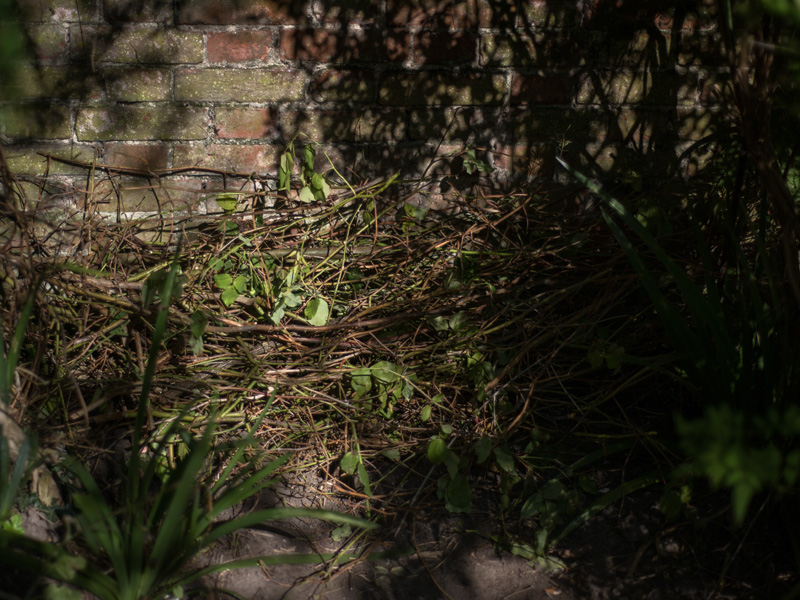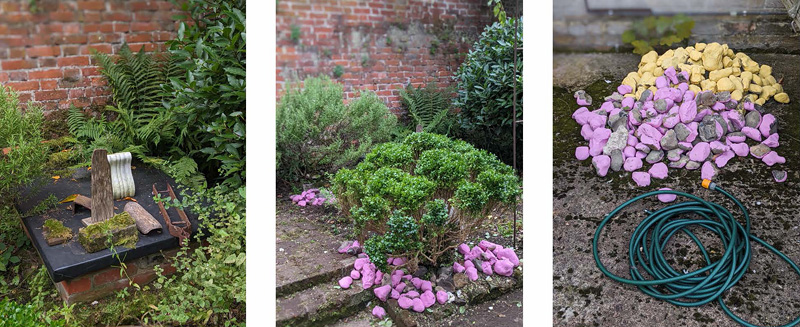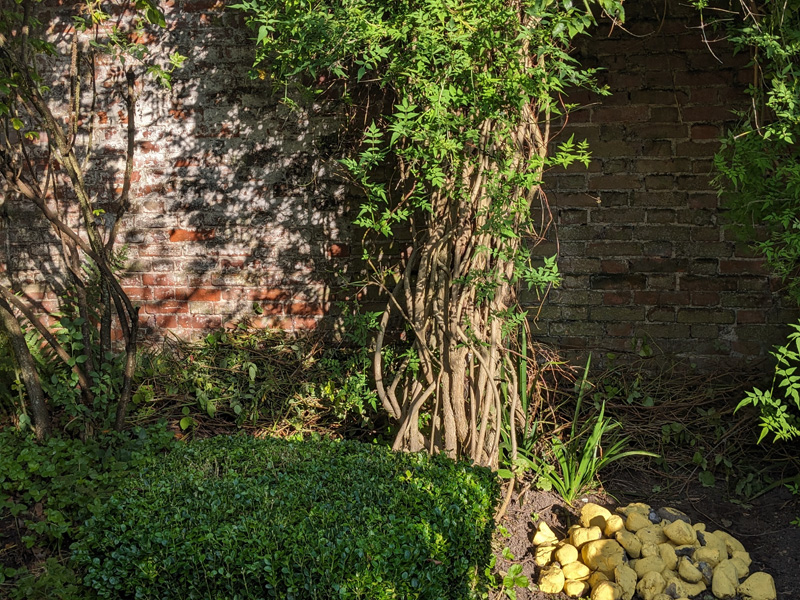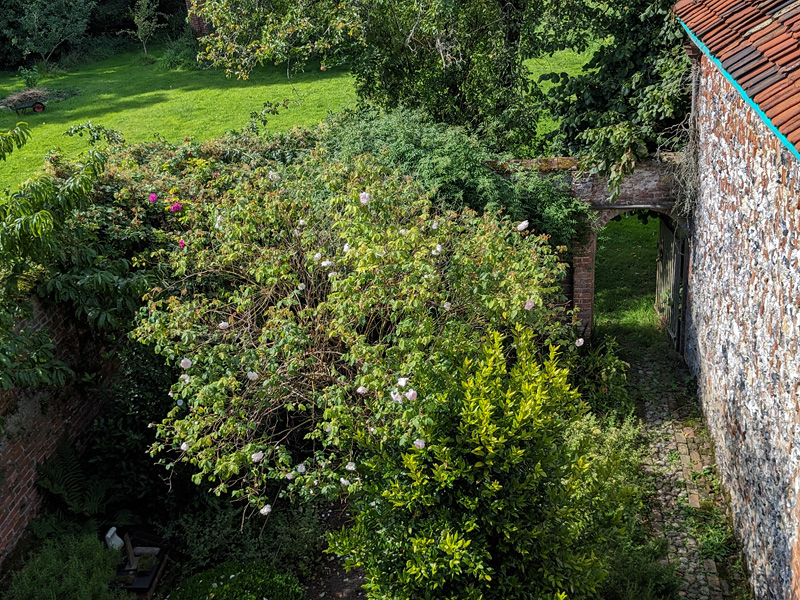Artist-Gardener-in-Residence at The Grange Projects (Aug 2023 – Oct 2024)
I’m excited to be artist-gardener-in-residence at The Grange in Great Cressingham, Norfolk. As someone who doesn’t have a garden of my own, this residency provides a rare opportunity to work within an historic walled herb garden and surrounding permaculture site, without compromise. Hosted by The Grange Projects and supported by Nicola Streeten and John Plowman.
My residency is made possible through the invaluable support of several funding bodies. An RHS bursary supports research into artist’s gardens, investigating artistic approaches to cultivated spaces. The Eaton Fund provides essential resources to further my creative exploration, while a Thistledown Horticultural Bursary, awarded by Tresco Abbey Gardens, covers accommodation, travel and training expenses. My work will document seasonal changes, experiment with planting schemes, and create site-responsive pieces reflecting the garden’s history and ecology; merging creative and horticultural practices in a dynamic, living environment. Below are my field notes summarising the residency and research period…..
FINAL REPORTS WRITTEN (December 2024)

If you’d like to receive PDF(s) of my funding report(s) and read more in depth about this residency/research period and my final reflections, do get in contact.
IN RESIDENCE: (October 2024)



My final visit of this residency period. Tasks completed:
- Removed collapsed dead stems.
- Pruned jasmine/hard pruned climbing rose.
- Weeded paths.
- Created more deadwood piles for habitats.
- Planted Crocosmia ‘Carmine Brilliant’, Perovskia atriplicifolia, Oxalis spp. and cardoon (Cynara cardunculus).
- Cut back lemon balm.
- Noted muntjacs have eaten Korean Aster, Welsh onions and salvia.
- Planted Allium nigrum, Allium sphaerocephalon, Nectaroscordum siculum and Iris ‘Picasso’ bulbs.
- Wove jasmine prunings into time gate (see below left).
- Trimmed marjoram, sowed fennel seed, planted jasmine cuttings by the arch.
- Researched muntjac repellent plants.



Below: Vietnamese coriander doing well (left) and planted cardoon (right).





The conflict between nature and art, chaos and order, wildness and civilisation sums up much of my thinking during this residency period. The creative gardening approach leaves space for the infinite becoming, shifting, changing and unbecoming of energetic states that happen in a garden. Accepting this reality and allowing space for chance and for co-creation with mystery is what I’ll take away from my time here plus the acceptance of conflict as a necessary circumstance for creativity, coincidently, similar to ideas Ian Hamilton Finlay explored at Little Sparta.
Moving forward, and inspired by Barbara Hepworth’s friendship with the advant-garde composer Priaulx Rainier (a passionate gardener and ecologist who helped design and plant the exotic plants in Hepworth’s garden), plus conversations with Nicola & John, I want to research further gendered gardens. Delving into how women transform green spaces into portals through time, and in turn how these gardens forge their creative lives as a place of sanctuary, inspiration, friendships and expression.
RESEARCH: Barbara Hepworth Sculpture Garden





















My final RHS Bursary research trip was to Barbara Hepworth’s Sculpture Garden in St Ives, Cornwall. By chance, I caught a fortuitous talk on the relationship between music and her work, which has opened up a whole new area of exploration for my own work, particularly the relationship between Barbara Hepworth and the advant-garde composer Priaulx Rainier who were friends.
Rainier was also a passionate gardener and ecologist who helped design and plant the exotic plants in Barbara Hepworth’s Sculpture Garden. They again collaborated on a film about Hepworth’s work, directed by Dudley Shaw Ashton, Barbara Hepworth: Figures in a Landscape with soundtrack composed by Rainier.
[A report to be written at a later date.]
RESEARCH: Topiary workshop with Charlotte Molesworth (September 2024)















I attended a topiary workshop with topiary artist Charlotte Molesworth at her incredible garden in Benenden, Kent, which included a tour of the garden that Charlotte and her husband Donald have been cultivating for 40 years. It’s organic, full of wildlife and has the most extraordinary pruned shapes made from yew and boxwood. Particular attention to the needs of nesting birds and small mammals lend this artistic plantswoman’s garden a rare and unusual quality.
As well as practice, there were demos on keeping box caterpillar at bay using organic controls, best tools advice and how to maintain plus shrubs/plants used. There’s plenty of Buxus at The Grange that I can practice these skills to create some ‘living sculptures’.
Part of research funded by an RHS & Thistledown Horticultural bursaries (report to be written at a later date).
IN RESIDENCE: Planted edible perennials (August 2024)
- Vietnamese coriander – Persicaria odorata
- Sculpit/Stridolo – Silene inflata (Bladder Campion)
- Musk mallow – Malva moschata
- Korean Aster – Doellingeria scabra (Aster scaber)
- Welsh onion – Allium fistulosum
- Red plantain – Plantago major
IN RESIDENCE: Relinquishing control: a case for bindweed? (August 2024)






IN RESIDENCE: Shifting Focus (August 2024)



It became apparent this trip that the focus of my time here is now changing from making an artist garden to utilising the garden as outdoor studio. Gardening as an artistic endeavour and environmental activism. With every visit the garden has grown to a state much worse than when I took on the challenge of looking after it. The internal, mental and emotional side of gardening now coming to the fore. How gardening can feel like a futile task sometimes – a case of going around in circles (circles being a recurring motif in the garden). It got me thinking about the process and value of care, how capitalist society undervalues invisible labour and human’s desire for control.
“Care is our individual and common ability to provide the political, social, material, and emotional conditions that allow the vast majority of people and living creatures on this planet to thrive – along with the planet itself.”
The Care Manifesto: The Politics of Interdependence, Care Collective.
RESEARCH: Little Sparta (August 2024)















I visited magical, mossy Little Sparta, Ian Hamilton Finlay’s greatest work of art, as part of my research into artist’s gardens (set in the Pentland Hills, near Edinburgh). Above, are a few of the 270 artworks spread across seven acres of wild and exposed moorlands. Ian Hamilton Finlay (1925 – 2006) was a poet, writer, visual artist and gardener.
I’m always looking for the poetry in a garden and this garden delivered in tonnes (both metaphorically and literally).
“Collaborating with stone carvers, letterers and at times other artists and poets, the numerous sculptures and artworks created by Finlay, which are all integral to the garden, explore themes as diverse as the sea and its fishing fleets, our relationship to nature, classical antiquity, the French Revolution and the Second World War. Individual poetic and sculptural elements, in wood, stone and metal, are sited in relation to carefully structured landscaping and planting. In this way, the garden in its entirety is the artwork.”
Part of research funded by an RHS bursary (report to be written at a later date).
RESEARCH: Levens Hall (August 2024)



My RHS bursary included a research trip to the world’s oldest topiary gardens, Levens Hall in Cumbria, to think about ‘living sculptures’ and biomorphic shapes (as there’s lots of box shrubs at The Grange that could be utilised as so). Overwhelming came away thinking about wealth and privilege instead, more food for thought!
[A report to be written at a later date.]
RESEARCH: Conference | Gardens for Museums (July 2024)
Thanks to the RHS Bursary, I was also able to attend this conference at Garden Museum. Speakers included:
- Neil Davidson, Landscape Architect/J&L Gibbons re Urban Nature Project at the Natural History Museum.
- Dr Paul Kenrick, lead scientist at Urban Nature Project at the Natural History Museum.
- Nathalie Glaser, Head of Corporate & Private Events, V&A.
- Katy Merrington, Cultural Gardener at The Hepworth Wakefield Garden.
- Peronel Craddock, Director of Content (Interim), Horniman Museum and Gardens.
- Edwina Sassoon, Garden Museum Trustee.
- Tom Stuart-Smith, Garden Designer at The Hepworth, Wakefield.
- Abigail Viner, Director of Creative Programmes and Engagement, Compton Verney.
How can green space outside a museum be used to build audiences and connect them with collections? How can they support income generation, commercial activity and the development of a sustainable business model? And what role do museum gardens have in the development of local cultural placemaking?
Main takeaways from the conference:
- How aftercare is as important as the design itself. Investing in a gardener(s) is key.
- Seasonal changes = repeat visits.
- How these spaces contribute to wellbeing and making people feel welcome/that they belong.
- Gardens are dynamic, museum collections are not.
- Care is epic and important.
- Increasing biodiversity and education on climate emergency as key outcomes.
Was interesting to hear Abigail Viner (Compton Verney) talking about heritage & contemporary art, exploring new narratives/perspectives and displaying artworks to engage audiences with hidden histories. Particularly, as I’m thinking about the garden itself as a form of archive (where the plants tell stories from the past; information becomes seeded and transmitted through the plant life the garden contains) plus, how gardens can reveal forms of knowledge and ways of being that are often left out of traditional archives/historical records.
RESEARCH: Charleston House (June 2024)






I received an RHS Bursary to do some research into artist’s gardens as part of this residency. The first trip was to see the gardens at Charleston (Lewes, Sussex), the modernist home, garden and studio of the painters Vanessa Bell and Duncan Grant of the Bloomsbury group. This group came together to imagine society differently at Charleston and it became a place where art and experimental thinking were at the centre of everyday life. The garden was designed as a ‘living painting’ and as Angelica Garnet said ‘…the garden here was not a gentleman’s garden or a gardener’s garden, it was always an artist’s garden’.
The Grange is a space that brings artists together to engage with art & ideas plus there’s similarities in rural location and characteristics of building materials used, so it felt pertinent to visit here as part of my research (a report will be written at a later date).
IN RESIDENCE: Progress (May 2024)



The satisfaction of leaving the garden much tidier than when I arrived, despite a week of rain and very soggy ground! My next visit will focus on planting.
IN RESIDENCE: Artist installation (May 2024)



Fellow artist-in-residence, Dorit Lavon Szternfeld, installed her sculpture waving, beewax on chickenwire, with the help of John Plowman.
IN RESIDENCE: Stone circles & hagstone (May 2024)



Created stone circles using left over artists materials and sowed borage and chives seeds in the round. Other seeds planted in the garden include nasturtiums, poppies, fennel, chamomille, nigella, and cornflower. Found a hagstone (a stone with a naturally occurring hole through it), such stones are believed to have magical properties!
IN RESIDENCE: Waste substrate & habitat to support wildlife (May 2024)



Leftover artist materials have been used as substrate for seed sowing. Another habitat to support wildlife created, again repurposing weeds and pruning materials.
IN RESIDENCE: Repurposing materials (May 2024)



All bay tree prunings were repurposed into bay circles hung on the entrance gate, which should in time turn the same colour as the rusty iron.
IN RESIDENCE: Cabinet of curiosities (May 2024)



Started collating found objects from the garden and site, inspired by the cabinet of curiosities at the Victorian school.
IN RESIDENCE: Aborted proceedings (May 2024)



Had to abort clipping as I found a blackbird’s nest in one of the bay trees (identified from the book found in the Victorian school adjacent to The Grange).
IN RESIDENCE: Tools at the ready (May 2024)






Back at The Grange to find the garden completely overgrown from all the rain this year, clearing the paths took up most of my time this trip.
RESEARCH: A period of hibernation (Winter 2023)



Sculpture for non-humans?
My next visit won’t be until Spring 2024, so plans for the rest of this year include:
- Take cuttings + collect/order seeds
- Research history of herb garden
- Research herbs to plant next year
- Make planting plan + timeline of work
- Apply for funding
IN RESIDENCE: Repurposing found objects (August 2023)



I started to gather found objects from around the grounds of The Grange, to potentially use in the garden, mostly materials discarded by other artists after their residencies, harnessing cyclic opportunities that already exist on site (in keeping with permaculture principles). Played around with placing the objects to see the visual effects this had. Will be interesting to see where this leads…
IN RESIDENCE: A garden for all animate beings (August 2023)



After an attempt to prune the climbing rose over the arch, the mass of dead wood removed has been dispersed around the edges of the garden to create a habitat for wildlife. As this is a permaculture site, we try as much as possible not to remove waste from the grounds. Woody branches take too long to break down in the compost so this is a good way to make use of the material. As the rose was still flowering, I will resume work on my next visit.
IN RESIDENCE: Before & after views (first visit, August 2023)





















Trying to gain some control of the herb garden (which hasn’t been maintained for several years), cutting back, deadheading, weeding and adding some structure. I don’t think taming and control will be a big part of my remit but wanted to strip it back so I could see the bones. Clipped some topiary shapes (in an attempt to undo the symmetry) and started to cloud prune another box shrub (in homage to the 150+ year old box).
IN RESIDENCE: Surveying the potential (August 2023)



View from above of the walled Herb Garden (August 2023)
IN RESIDENCE: The starting inspiration (August 2023)



This is European box (Buxus sempervirens) situated within the grounds at The Grange, a work of art in itself. Possibly planted 150+ years ago when the home was built. It brings to mind Ash Dome, a living sculpture made by the artist David Nash in North Wales (a circle of 22 ash trees that gradually change over time, like the environment around it). I’m particularly keen to make a connection to this fine specimen in the herb garden and initial ideas include cloud pruning the box already in the garden, exposing stems of the plant to create some interesting negative spaces.




